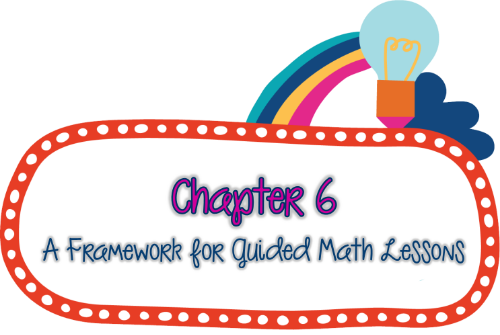Chapter 6 is all about how to plan a Guided Math lesson. It was relatively short, but there was some really good stuff inside. I especially enjoyed the "peek in" of a Guided Math lesson.

Dr. Newton provides a framework for guided math that is broken into 3 sections. These sections include the mini-lesson, student practice, and share time.
- Mini-Lesson In the mini-lesson, it is our job as teachers to hook the students into that day's learning. We do this by making some kind of connection. I like to make the connection by telling a story. My students love to hear stories about my life or when I was a student in college and I always do my best to tie the story back to the lesson. After the hook, it is time to demonstrate the material.
- Student Practice After the teacher demonstration, it is time for the students to practice the skill being taught. This is the part of the lesson where the teacher and the student interact and discuss what they are doing as they work through the lesson. This would be a time for using whiteboards or playing games.
- Share Time The final part of the lesson is the share time, where students are asked questions about what they did during their practice time. Students can be interviewed one at a time or they can be asked to retell the main points of the lesson. The share time is then concluded by reinforcing the concepts one more time to clarify any confusion the students may have. The math centers are then explained and that group of students is released to go work.
The key take-away from this chapter is the need to plan out the lessons. Guided math is not something that can be done by the seat of your pants. It takes careful planning to be effective

Question 1: I have never been one to use a Guided Math lesson plan. Because of the way I build my small groups, I tend to do many of the same things each time I meet with a group. The key thing is that I already include all of the aspects of a guided math lesson when I meet with my small groups. We begin by reviewing the material. I show the students a couple of examples. The students are then given the opportunity to practice the lessons. Finally, we discuss what was done. I would like to become more conscientious about doing a more formal plan.
Question 2: When teaching from the concrete to the pictorial to the abstract, I always start with manipulatives. This can include base-10 blocks or coins or even cards. The students need something to hold in their hands. After they are used to moving the objects around, I show them how to draw pictures. A good example of this is showing the students how to draw arrays for multiplication. I also show the students how to use large squares, lines, and dots when using base-10 numbers. I have a blog post that I really need to write on how I teach my students to solve multiplication problems. I've been trying to write it for months.
It's hard to believe that we are almost finished with this book. Be sure to leave a comment about how you plan your guided math lessons or ways that you move from concrete to pictorial. I would love to hear some new ideas.

I agree, using math tools (manipulatives) to understand problems and represent thinking is so important at all grade levels. When I used to teach fifth grade they came in with little experience doing this--this should never be taken away as a step in the process. :0) Thanks for sharing your dice link in your comment on our blog--love using dice with the kids! Thanks so much for sharing!
ReplyDeleteSmiles,
Sarah